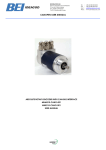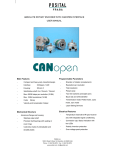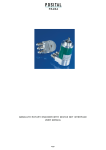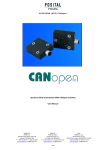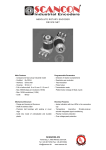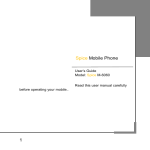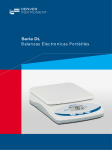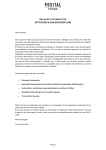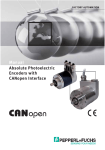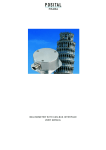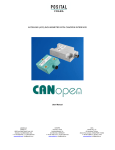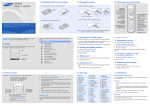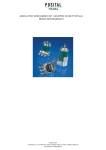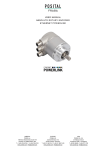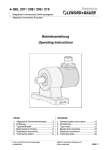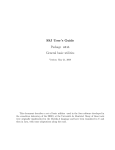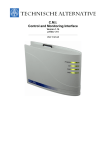Download absolute rotary encoder with can-bus
Transcript
ABSOLUTE ROTARY ENCO DER W ITH CAN-BUS INTERFACE USER MANUAL Imprint FRABA POSITAL GmbH Disclaimer of Warranty FRABA POSITAL GmbH Schanzenstraße 35 D-51063 Köln representations or warranties, either express or implied, by or with respect to anything in this Telefon +49 (0) 221 96213-0 Telefax +49 (0) 221 96213-20 manual, and shall not be liable for any implied warranties of merchantability and fitness for a Internet e-mail particular purpose or for any indirect, special, or consequential damages. http://www.posital.com [email protected] makes no Copyright Version date: 24. September 2004 The company FRABA POSITAL GmbH claims copyright on this documentation. It is not allowed to Version number: Article number: 2.3 99998101 modify, to extend, to hand over to a third party and to copy this documentation without written approval Author: Marcus Staszewski / Klaus Matzker by the company FRABA POSITAL GmbH. Nor is any liability assumed for damages resulting from the use of the information contained herein. Further, this publication and features described herein are subject to change without notice. Alteration of Specifications reserved Technical specifications, which are described in this manual, are subject to change due to our permanent strive to improve our products. Page 2 UME-OCD-CAN Version 09/04 1. Introduction...................................................... 4 1.1 Absolute rotary encoder................................... 4 4.5.3 Limit switch, max: ........................................27 4.5.4 Programming example: Limit switch, Max.: .28 1.2 CANopen technology ....................................... 4 1.3 CAN Communication Reference Model ........... 6 4.6 Changing the node number............................28 4.6.1 Example: Changing the node number .........29 1.4 Definitions ........................................................ 7 4.7 Adjusting the baudrate ...................................30 4.7.1 Example : Adjusting the baudrate ...............31 2. Installation ........................................................ 8 2.1 Electrical Connection ....................................... 8 4.8 Transmission Mode ........................................31 4.8.1 Cyclic Mode.................................................31 2.1.1 Bus connection ............................................. 9 2.1.2 Cable connection .......................................... 9 4.8.2 Disable the cyclic mode ..............................32 4.8.3 Sync Mode ..................................................32 2.1.3 Bus Termination............................................ 9 2.2 Bus address................................................... 10 4.8.4 Example: Number of Sync telegrams ..........33 4.8.5 Polled Mode ................................................33 2.2.1 Setting of the node number......................... 10 2.3 Setting of the baudrate................................... 10 4.9 Memory Transfer............................................34 4.10 Wiederherstellen der Standardeinstellungen35 2.4 Meaning of the LEDs in the connection cap... 11 2.5 Troubleshooting ............................................. 12 5. Technical Data................................................35 3. Device Configuration..................................... 13 5.1. Electrical Data ...............................................35 5.2. Mechanical Data ...........................................35 3.1. CANopen data transmission ......................... 13 3.1.1 The COB-ID ................................................ 13 5.3 Mechanical Drawings .....................................37 5.4 Cable and connectors ....................................46 3.1.2 The Command Byte .................................... 14 3.1.3 The Object Directory ................................... 15 6. Models/Ordering Description ........................49 3.3.1 Manufacturer Specific Objects .................... 16 3.2 Operational Status ......................................... 17 6.1 Combinationmatrix .........................................50 6.2 Connection caps ............................................50 3.2.1 Status: Operational ..................................... 17 3.2.2 Status: Pre-Operational .............................. 17 6.3 Accessories and documentation ....................51 3.2.3 Reset of the absolute rotary encoder .......... 18 3.3 Transmission of the Actual Position ............... 18 7. Appendix.........................................................52 7.1 History encoder generations ..........................52 4. Programming ................................................. 19 7.1.1 Encodergeneration Optocode .....................52 7.1.2 Encodergeneration AWC.............................52 4.1 Operating Parameters.................................... 19 4.1.1 Programming example: Operational 7.2 List of tables ...................................................55 7.3 List of figures..................................................55 parameter ............................................................ 20 4.2 Resolution per Revolution.............................. 21 7.4 Document history ...........................................55 4.2.1 Programming example: Resolution per revolution ............................................................. 22 4.3 Total resolution .............................................. 22 4.3.1 Programming example: Total resolution ..... 24 4.4 Preset Value .................................................. 25 4.4.1 Programming example: Preset value .......... 25 4.5 Limit Switch, Min. and Max. ........................... 26 4.5.1 Limit switch, Min:......................................... 26 4.5.2 Programming example: Limit switch, min. ... 27 Version 09/04 UME-OCD-CAN Page 3 1. Introduction This manual describes the implementing and - Node number configuration of an absolute rotary encoder with CANopen interface. The device fullfills the - velocity requirements of a CANopen device regarding the device specification DS406 of the CANopen The general use of absolute rotary encoders with CAN-Bus interface using the CAN Open user group. protocol is guaranteed. 1.1 Absolute rotary encoder The basic principle of an absolute rotary encoder 1.2 CANopen technology CAN stands for Controller Area Network and is the optical sampling of a transparent code disc which is fixed with the driving shaft. was developed by the company Bosch for applications within the automobile area. In the The absolute rotary encoder has a maximum resolution of 65536 steps per revolution (16 Bit). meantime CAN has become increasingly used for industrial applications. CAN is a multi - The Multi-Turn version can detect up to 16384 revolutions (14 Bit). Therefore the largest masterable system, i.e. all users can access the bus at any time as long as it is free. CAN 30 resulting resolution is 30 Bit = 2 = 1.073.741.824 steps. The standard Single -Turn doesn?t operate with addresses but with message identifiers. Access to the bus is version has 12 Bit, the standard Multi -Turn version 24 Bit. performed according to the CSMA/CA principle (carrier sense multiple access with collision For further information about the function avoidance), i.e. each user listens if the bus is free, and if so, is allowed to send messages. If principle or the setup of a CANopen net work please refer two users attempt to access the bus simultaneously, the one with the highest priori ty http://www.posital.com/products/encoder_abc/en coder_abc.html (lowest identifier) receives the permission to send. Users with lower priority interrupt their Open functions. The following modes can be data transfer and will access the bus when it is free again. Messages can be received by every programmed and enabled or disabled: - Polled Mode participant. Controlled by an acceptance filter the participant accepts only messages that are - Cyclic Mode - Sync Mode intended for it. CANopen Transmission Technology: Two-core cable The protocol supports the programming of the following additional functions: Baud rates: Participants: 20 kBaud up to 1 MBaud maximum 127 Cable Length: 30 m for 1 MBaud 5000 m for 20 kBaud - Code sequence (Complement) Resolution per revolution - Total revolutions Preset value The data communication is done via message - Two limit switches Baudrate telegrams. In general, telegrams can be split in a COB-Identifier and up to 8 following bytes. The Page 4 UME-OCD-CAN Version 09/04 COB-Identifier, which determines the priority of the message, is made from the function code required to answer after each sync message, a parameter sync counter and the node number. can be programmed to skip a certain number of sync messages before The node number is uniquely assigned to each user. With a FRABA rotary encoder this number answering again is assigned with by numerical coded turn switches in the connection cap. The function - code varies according to the type of message transmitted: Change of state mode: The position value is transferred when changing - Administrative messages (LMT, NMT) Further functions (direction of rotation, resolution,etc..) can be parameterized. FRABA - Service data objects (SDOs) Process data Objects (PDOs) rotary encoders correspond with the class 2 profile for encoder (DSP 406), whereby the pre-defined messages emergency messages) characteristics of rotary encoders with CANopen interface are defined. The link to the bus is made - (synchronization, PDOs (Process Data Objects) are needed for by terminal blocks in the connection cap. In additon, the node number and Baud rate are set real time data exchange. Since this messages possess a high priority, the function code and with turn switches. For configuration and parameterization various software tools are therefore the identifier are low. SDOs (service data objects) are necessary for the bus node available from different providers. With the help of the provided EDS file (electronic datasheet) configuration (e.g. transfer of device parameters). Because these message telegrams simple line-up and programming are possible. are tranferred acyclicly (usually only while powering up the network), the priority is low. FRABA rotary encoders with CANopen interface support all CANopen functions. The following operating modes can be programmed: - Polled mode: The position value is only given upon request - Cyclic Mode: The position value is written cyclically (interval adjustable) to the bus - Sync mode: After receiving a sync message by the host, the encoder answers with the current process value. If a node is not Version 09/04 UME-OCD-CAN Page 5 1.3 CAN Communication Reference Model The communication concept can be described similar to the ISO -OSI Reference Model: Device A Device B Device C Device X ISO/OSI Layer 7: CAL NMT DBT LMT CMS ISO/OSI Layer 2: Data Link Layer ISO/OSI Layer 1: Physical Layer CAN Bus The communication model* supports synchronous and asynchronous messages. With respect to the functionality four different message objects are provided: Administrational Messages (LMT, NMT) Service Data Messages (SDO) Process Data Messages (PDO) Pre-defined Messages (Synchronisation and Emergency Messages) Further information is available at: CAN in Automation (CiA) International Users and Manufacturers Group e.V. Am Weichselgarten 26 D-91058 Erlangen (*) Reference: CAN Application Layer for Industrial Applications CiA Draft Standard 201 ... 207, Version 1.1 CAL-based Communication Profile for Industrial Systems CiA Draft Standard 301 Page 6 UME-OCD-CAN Version 09/04 1.4 Definitions CAN Controller Area Network Additionally, following abbreviations are used in the CAL CMS CAN Application Layer CAN Message Specification. manual: One of the service elements of the application layer in the CAN Reference APV CW Absolute Position Value Clockwise. Turning direction as seen on Model. Communication Object. (CAN message) CCW shaft. Counterclockwise. Turning direction as A unit of transportation in a CAN Network. Data must be sent across a Network FC seen on shaft. Function code. It determines the kind of COB inside a COB. COB-ID COB-Identfier. Identifies a COB uniquely LMT message, which is sent across the CAN network. in a Network. The identifier determines the NN priority of that COB. Layer Management. One of the service PV PCV Node number. It determines uniquely the CAN device. Preset value Process value elements of the application layer in the CAN Reference Model. It serves to configure parameters of each layer in the CAN NMT Reference Model. Network Management. One of the service elements of the application layer in the CAN Reference Model. It performs initialisation, configuration and error handling in a CAN SDO network. Service Data Object. A data object with PDO low priority to configure a CAN node. Process Data Object. A data object with high priority to synchronous and transmit data in asynchronous modes. Version 09/04 UME-OCD-CAN Page 7 2. Installation 2.1 Electrical Connection The rotary encoder is connected by three cables. The power supply is achieved with a two-wire Clamp Description connection cable through one PG 9. Each one of the twisted-pair and shielded bus lines are guided ⊥ Ground + 24 V Supply voltage - 0 V Supply voltage CG CAN Ground CL CAN Low CH CAN High CG CAN Ground CL CAN Low CH CAN High in and out through two PG 9 on the right side (as seen on clamps) Instructions to mechanically install and electrically connect the angular encoder Do not remove or mount the connection cap while the encoder is under power! RT ON Do not stand on the encoder! - G L 78 78 L 901 23 23 23 456 456 456 Do not adapt the driving shaft additionally! H G 901 901 78 + Bd x10 x1 Avoid mechanical load! Do not adapt the housing Fig. 1 Connection cap inside additionally! BCD coded rotary switches Dvice address 0...89 x1 Setting CAN-node number x10 Adress reserved 90…99 xBd Setting of the baud-rate H RT 2.1.1 Bus connection The connection cap fulfills the function of a T - ON coupler. From there the wiring must be done according to the drawing on the left side. Please note the assignment of incoming and outgoing bus signals. + - G L H G L H An Bus In activated bus termination resistor will lead into a separation of bus in and bus out signals! Bus Out 2.1.2 Cable connection Remove screw, sealing and cone from the cable gland. Remove 55 mm of the sheat and 50 mm of the shielding. About 5 mm of the wires should be de-isolated. Put screw, and sealing on the cable. The cone should be mounted under the shielding according to the figure 3. Put the whole cable into the cable gland and tighten the screw. Fig. 3 Connection cap bus in and bus out 2.1.3 Bus Termination If the encoder is connected at the end or beginning 55 mm 50 mm 5 mm 5 mm of the bus the termination resistor must be switched on. The termination resistor is switched on when the switch is in the ON posit ion. Separation of Bus In and Bus Out signals if termination resistor is Fig. 4 Cable preparation activated. There is a resistor provided in the connection cap, which must be used as a line termination on the last device. Resistor: RT Fig. 2 Cable connection ON Last Device Version 09/04 UME-OCD-CAN RT ON Device X Page 9 2.2 Bus address Baudrate in kBit/s BCD coded rotary switches The setting of the node number is achieved turnswitches in the connection cap. Possible (valid) 20 0 addresses lie between 0 and 89 whereby every address can only be used once. 2 LEDs on the 50 1 100 2 125 3 250 4 500 5 The CANopen Encoder adds internal 800 6 1 to the adjusted device address. 1000 7 reserved 8..9 backside of the connection cap show the operating status of the encoder. 2.2.1 Setting of the node number The setting of the node number is achieved by two turn-switches in the connection cap. The customer can easily remove the connection cap for installation by removing two screws at the backside of the encoder. The meaning and the positioning of the two turn-switches you can see in figure 1. Tab. 2 Assignment baudrate and turn switch If the device has a connector or a cable exit instead of a connection cap the node number can only be adjusted via SDO objects. The default baudrate is 20 kBaud. Please regard point 4.7 for further information about setting of the baudrate via SDO objects. If the device has a connector or a cable exit instead of a connection cap the node number can only be adjusted via SDO objects. The default node number is in this case 32. Please regard point 4.6 for further information of setting the node number via SDO objects. 2.3 Setting of the baudrate The adjusting of the baudrate is achieved by one turn switch in the connection cap.The following baudrates are possible: Protocol Definition via BCD address switches x1 Device address 97 x10 Automatic protocol selection according to kind of connection cap x1 Device address 98 x10 Protocol selection according to DS301 -V3 x1 Device address 99 x10 Protocol selection according to DS301 -V4 Tab. 1 Protocol definition via BCD turn switches Page 10 UME-OCD-CAN Version 09/04 2.4 Meaning of the LEDs in the connection cap LED grün green LED grün /green Err Sta Fig. 5 Backside connection cap Err Green LED Sta Green LED Meaning off off No power supply off on Encoder is ready, Boot Up message not sent (no further device on network, wrong baud rate) or encoder in prepared status flashing on Boot Up message sent, device configuration is possible on on Normal operation mode, Encoder in Operational Status Tab. 3 Meaning status LED’s Version 09/04 UME-OCD-CAN Page 11 2.5 Troubleshooting 2.5.4 Limit switches without function 2.5.1 Power on – Encoder doesn’t respond Problem: The encoder didn’t transmit the bits for the limit Problem: The bus is active but the installed encoder switches. transmitted no boot up message. Possible solution: The limit switch functionality has to be activated Possible solution: switch of the PLC once. Please follow the descripting you can find at 4.5. - remove the connection cap of the encoder check the 2 turn-switches for th baudrate Assemble the connection cap power on 2.5.5 Encoder without connection cap, Version C5 und C6 2.5.2 Malfunction of the position value during Notice: The changing of baudrate and node number are only valid after a new power up, NMT transmission Reset Problem: During the transmission of or the store parameters command. the position value occasional malfunctions occurs. The CAN bus can be temporabily in the bus off stat e also. Possible solution: Check, if the last bus node has switched on the terminal resistor. If the last bus node is an encoder the terminal resistor is suited in the connection cap.. 2.5.3 Too much ERROR-Frames Problem: The bus load is too high in case of too much error frames. Possible solution: Check if all bus node has the same baudrate. If one node has another baudrate error frames are produced automatically. The setting of the baudrate is descripted in this manual under 2.2 and 4.6. Page 12 UME-OCD-CAN Version 09/04 3. Device Configuration 3.1. CANopen data transmission The data transmission in the CAN network is realised by message telegrams. Basically, these COB-ID Command Index 11 Bit Byte 0 Byte 1 Byte 2 Low High telegrams can be divided into the COB-ID and 8 following bytes as shown in the table below: Subindex Service-/Process- Data Byte 3 Byte 4 Byte 5 Byte 6 Byte 7 Low → → High 3.1.1 The COB-ID The 11 Bit of COB-Identifier is built as follows: 10 9 8 7 Function code X The X X 6 5 4 3 2 1 0 X X X X Node number X COB-Identifier X X determines X uniquely X: free selectable the The node number can be adjusted by 2 rotary message object. It is built by the function code, identifying the message class and the node switches in the connection cap or optionally on customer request by a SDO. number, which determines the absolute encoder. Following function codes are available: Object Function Code (Binary) (rx) and (tx) as seen by the master ! Result. COB-ID Priority Class* NMT 0000 0 0 SYNC 0001 128 0 Emergency 0001 129 - 255 0,1 PDO (rx) 0011 385 - 511 1,2 PDO (tx) 0100 513 - 639 2 PDO (rx) 0101 641 - 767 2,3 PDO (tx) 0110 769 - 895 3,4 SDO (rx) 1011 1409 - 1535 6 SDO (tx) 1100 1537 - 1663 6,7 Tab. 4 Overview priority of the CANopen objects *Priority: 0 = highest priority, 7 = lowest priority Version 09/04 UME-OCD-CAN Page 13 3.1.2 The Command Byte The command byte contents the kind of telegram The Request-Telegram is used by the master to which is sent across the CAN network. One divides three kinds of telegrams: a Set-Parameter- read back stored parameters from a node. Telegram (Domain Download), a RequestTelegram (Domain Upload) and Warnings. Warnings are sent by the absolute rotary encoder to the master, if a sent telegram cannot be processed accordingly. The Set-Parameter-Telegram is used to send parameter data configuration. to the encoder (node) for Command Function Telegram Description 22h Domain Download Request Parameter to encoder 60h Domain Download Confirmation Parameter received 40h Domain Upload Request Parameter request 43h, 4Bh, 4Fh (*) Domain Upload Reply Parameter to Master 80 h Warning Reply Transmission error Tab. 5 Command description (*)The value of the command byte depends on the data length of the called parameter: Command Data length Data length 43h 4 Byte Unsigned 32 4Bh 2 Byte Unsigned 16 4Fh 1 Byte Unsigned 8 Tab. 6 Data length against command byte Page 14 UME-OCD-CAN Version 09/04 3.1.3 The Object Directory The data transmission according to CAL is realised exclusively by object oriented data messages. The objects are classified in groups by an index record. Each index entry can be subdivided by sub indices. The overall layout of the standard object dictionary is shown beside: Index (hex) Object 0000 not used 0001-001F Static Data Types 0020-003F Complex Data Types 0040-005F Manufacturer Specific Data Types 0060-0FFF Reserved for further use 1000-1FFF Communication Profile Area 2000-5FFF Manufacturer Specific Profile Area 6000-9FFF Standardised Device Profile Area A000-FFFF Reserved for further use Tab. 7 General object dictionary Following objects according to the communication profile CAN OPEN (refer to DS 301) are implemented into the absolute rotary encoder: Index Object Name Data Length Attr. 1000h VAR Device type Unsigned32 const 1001h VAR error register Unsigned8 ro 1002h VAR manufacturer status register Unsigned32 ro 1003h ARRAY pre-defined error field Unsigned32 ro 1004h Reserved for compatibility reason 1005h VAR COB-ID SYNC-message Unsigned32 rw 1008h VAR device name Vis-String const 1009h VAR hardware version Vis-String const 100Ah VAR software version Vis-String const 100Bh Reserved for compatibility reason 1010h VAR Store parameters Unsigned32 rw 1011h VAR Restor parameters Unsigned32 rw Tab. 8 Object dictionary according DS301 Version 09/04 UME-OCD-CAN Page 15 3.3.1 Manufacturer Specific Objects Additionally, following manufacturer specific communication objects are implemented: Index Subindex Object 1800h Name Data length RECORD Communication parameter PDO 1 Attr. ro 1800h 0h VAR number of supp. entries Unsigned 8 ro 1800h 1h VAR COB-ID used by PDO Unsigned 32 rw 1800h 2h VAR transmission type Unsigned 8 rw 1800h 3h VAR inhibit time Unsigned 8 rw 1802h RECORD Communication parameter PDO 2 1802h 0h VAR number of supp. entries Unsigned 8 ro ro 1802h 1h VAR COB-ID used by PDO Unsigned 32 rw 1802h 2h VAR transmission type Unsigned 8 rw 1802h 3h VAR inhibit time Unsigned 8 rw 2000h VAR process value Unsigned 32 ro 2100h VAR operating parameters Unsigned 16 rw 2101h VAR resolution/revolution Unsigned 16 rw 2102h VAR total resolution Unsigned 32 rw 2103h VAR preset value Unsigned 32 rw 2104h VAR Limit switch, min. Unsigned 32 rw 2105h VAR Limit switch, max. Unsigned 32 rw 2200h VAR Cycle time Unsigned16 rw 2300h VAR Store parameters Unsigned32 wo Tab. 9 Manufacturer specific object dictionary Index Subindex Objekt Name Datenlänge Attr. 3000h VAR Knotennummer Unsigned 8 rw 3001h VAR Datenrate Unsigned 8 rw Tab. 10 Nodenumber and baudrate The programmable communication objects and encoder parameters are explained in detail in the next chapter. VAR: Variable RECORD: Data field ARRAY: Data field ro: read only rw: read, write wo: write only Page 16 UME-OCD-CAN Version 09/04 3.2 Operational Status The absolute rotary encoder accesses the CAN network 4 s after power on in pre -operational status: FC NN 1110 XXXXXXX Comand Index Subindex S-/P-Data Description Boot-Up message All values except the FC are hexadecimal It is recommended, to set the parameters (see: 7.2 Programming) while the Encoder is in the pre - correctness of the sent/received SDOs. As it is not possible to send or receive PDOs in pre - operational status. During this status activity on the network is low what makes it easier to prove the operational status, stress for the Encoder will be reduced. 3.2.1 Status: Operational To put one or all nodes in the operational state, following message is sent by the master: FC NN 0000 b 0 d Command Index 01 h 00 Subindex S-/P-Data Description NMT-Start, all nodes 0000 b 0 d 01 h NN It is possible to put all the nodes in operational NMT-Start, NN status (Index 0) or only one node (Index NN). 3.2.2 Status: Pre-Operational To set one node in the Pre-Operational state the following telegram has to be transmitted from the master: FC NN Command Index 0000 b 0d 80 h NN Subindex S-/P-Data Description NMT-PreOp, NN NN: node number Version 09/04 UME-OCD-CAN Page 17 3.2.3 Reset of the absolute rotary encoder If a node is not functioning well, it is recommended to perform a RESET: FC NN Command Index Subindex S-/P-Data 0000 b 0 d NN: node number 81 h NN Description NMT-Reset, NN The notified Absolute Rotary Encoder accesses the bus in pre -operational status after resetting . 3.3 Transmission of the Actual Position The process value is sent across the CAN network with the following telegram: COB-ID Process value 11 Bit Byte 0 7 2 to 2 Byte 1 0 2 15 to 2 Byte 2 8 2 23 to 2 Byte 3 16 2 31 to 2 24 The COB-ID contains the node number and the according PDO(rx). By default the process value is sent with the function code PDO(rx) 0011 and as a response to the Sync -telegram with the function code PDO(rx) 0101. Page 18 UME-OCD-CAN Version 09/04 4. Programming The setting of parameters should be done always in pre-operational status. The monitoring Following values are written in hexadecimal notation with the exception of the function of the sent and received messages becomes much easier. code which value is given binary and the node number (decimal value). It is important to follow the presented sequence of the parameter settings. If values of Every parameter has a general description and an example. parameters are not changed then they can be skipped. 4.1 Operating Parameters As operating parameters the code sequence (Complement) can be selected and the limit switches can be turned on or off. CMS Index Default value Value range Data length SDO 2100h 0h 0h - Fh Unsigned16 General parameter description Master to Absolute Rotary Encoder: FC NN SDO(tx) 1100 b 1-90 d Set-Parameter Command Index Download 2100h 22 00 Subindex Service/Process data Byte 4 21 The parameter code sequence (Complement) determines the counting direct ion, in which the output process value increases or decreases. The code sequence is determined by Bit 0 in Index 2100h: 00 Byte 5 Byte 6 Byte 7 X 00 00 00 X: Hex value of bit combination bit 0 -2 Bit 0 Code sequence Code 0 CW increasing 1 CCW increasing Additionally, the two limit switches, Min. and Max. can be turned on or off in Index 2100h: Bit 1 Limit switch, min. Bit 2 Limit switch, max. 0 turned off 0 turned off 1 turned on 1 turned on Version 09/04 UME-OCD-CAN Page 19 After a successful tramnsmission the encoder answered with the following confirmation telegram: FC NN SDO(rx) 1011 b 1-90 d Command Index Subindex Download 2100h 60 00 21 00 Service/Process data Byte 4 Byte 5 Byte 6 Byte 7 00 00 00 00 4.1.1 Programming example: Operational parameter Target: Absolute rotary encoder with direction CCW increasing and both limit switches disabled Bitmatrix: Bit 0 = 1 Bit 1 = 0 Direction increasing (CCW) Limit switch min. disabled Bit 2 = 0 Limit switch max. disabled Result bitmatrix X = 01h Nodenumber NN = 01 Master to Absolute Rotary Encoder: FC NN SDO(tx) 1100 b 01 d Command Index Download 2100h 22 00 Absolute Rotary Encoder to Master: FC NN SDO(rx) 1011 b Page 20 01 d Set-Parameter Subindex 21 Service/Process data Byte 4 Byte 5 Byte 6 Byte 7 00 01 00 00 00 Subindex Service/Process data Confirmation Command Index Download 2100h 60 00 21 00 UME-OCD-CAN Byte 4 Byte 5 Byte 6 Byte 7 00 00 00 00 Version 09/04 4.2 Resolution per Revolution The parameter Resolution per Revolution is used revolution. Each value between 1 and 65536 can to program the desired number of steps per be realised. CMS Index Default value Value range Data length SDO 2101h (*) 0h - 8000h Unsigned16 (*) see: type sign The following value range is valid for a resolution per revolution of 16 bit Version 09/04 UME-OCD-CAN Page 21 CMS Index Default value Value range Data length SDO 2101h (*) 0h - 10000h Unsigned32 (*) see: type sign General parameter description Master to Absolute Rotary Encoder: FC NN SDO(tx) Set-Parameter Command Index Subindex Download 2101h 1100 b 1-90 d 22 01 X: desired resolution per revolution (>15 Bit) 21 00 Service/Process data Byte 4 Byte 5 Byte 6 Byte 7 X X Y Y Y: desired resolution per revolution (16 Bit) If the desired value exceeds the hardware resolution of the encoder, the code will not be transmitted stepwise. So it is important, to keep the parameter in the possible value range. After a successful tramnsmission the encoder answered with the following confirmation telegram: FC NN SDO(rx) 1011 b 1-90 d Command Index Download 2101h 60 01 Subindex 21 00 Service/Process data Byte 4 Byte 5 Byte 6 Byte 7 00 00 00 00 4.2.1 Programming example: Resolution per revolution Target: Absolute rotary encoder with 4096 steps per revolution Resolution per revolution: 4096 steps = 1000 h Node Number NN = 1 Master to Absolute Rotary Encoder: FC NN SDO(tx) 1100 b 1-90 d Command Index Download 2101h 22 01 Absolute Rotary Encoder to Master: FC NN SDO(rx) 1011 b 1-90 d Set-Parameter Subindex 21 Service/Process data Byte 4 Byte 5 Byte 6 Byte 7 00 X X Y Y Subindex Service/Process data Confirmation Command Index Download 2101h 60 01 21 00 Byte 4 Byte 5 Byte 6 Byte 7 00 00 00 00 4.3 Total resolution Page 22 UME-OCD-CAN Version 09/04 This parameter is used to program the desired number of measuring units over the total measuring range. This value must not exceed the total resolution of the absolute rotary encoder, w hich is printed on the type plate of the encoder. CMS Index Default value Value range Data length SDO 2102h (*) 0h - 4.000.000h Unsigned32 (*) refer to: type plate of encoder Attention: Following formula letter will be used: PGA PAU Physical total resolution of the encoder Physical resolution per revolution GA Total resolution (customer parameter) AU Resolution per revolution (customer parameter) (see type shield) (see type shield) If the desired resolution per revolution is less than the really physical resolution per revolution of the encoder, then the total resolution must be entered as follows: Total resolution: GA = ( PGA ∗ AU ) , AU ≤ PAU PAU Calculation example: Customer handicap: AU = 2048, Encoder type shield: PGA=24 bit, PAU=12bit Version 09/04 Fig. 6 Calculation formula for total resolution GA = (16777216 ∗ 2048 ) 4096 GA = 8388608 UME-OCD-CAN Page 23 If the total resolution of the encoder is less than the physical total resolution, the parameter total k= resolution must be a multiple of the physical total resolution: General parameter description Master to Absolute Rotary Encoder: FC NN SDO(tx) 1100 b 1-90 d PGA , k = ganze Zahl GA Set-Parameter Command Index Download 2102h Subindex 22 02 21 00 Service/Process data Byte 4 Byte 5 Byte 6 Byte 7 X X X X X: desired total resolution After a successful transmission the encoder answered with the following confirmation telegram: FC NN SDO(rx) 1011 b 1-90 d Command Index Download 2102h Subindex 60 02 21 00 Service/Process data Byte 4 Byte 5 Byte 6 Byte 7 00 00 00 00 4.3.1 Programming example: Total resolution Target: Absolute rotary encoder with a total resolution of 24 bit Total resolution 24 bit is equivalent to 1000000 h Node number NN = 1 Master to Absolute Rotary Encoder: FC NN SDO(tx) 1100 b 01 d Set-Parameter Command Index Download 2102h Subindex 22 02 21 00 Service/Process data Byte 4 Byte 5 Byte 6 Byte 7 00 00 00 01 X: desired total resolution After a successful transmission the encoder answered with the following confirmation telegram: FC NN SDO(rx) 1011 b Page 24 01 d Command Index Download 2102h Subindex 60 02 21 00 UME-OCD-CAN Service/Process data Byte 4 Byte 5 Byte 6 Byte 7 00 00 00 00 Version 09/04 4.4 Preset Value The preset value is the desired position value, The preset value must not exceed the parameter which should be reached at a certain physical position of the axis. The position value is set to the total resolution to avoid run-time errors. desired process value by the parameter preset. CMS Index Default value Value range Data length SDO 2103h 0h 0h - total resolution Unsigned32 General parameter description Master to Absolute Rotary Encoder: FC NN SDO(tx) 1100 b 1-90 d Set-Parameter Command Index Subindex Download 2103h 22 03 21 00 Service/Process data Byte 4 Byte 5 Byte 6 Byte 7 X X X X X: desired preset value After a successful transmission the encoder answered with the following confirmation telegram: FC NN SDO(rx) 1011 b 1-90 d Command Index Subindex Download 2103h 60 03 21 00 Service/Process data Byte 4 Byte 5 Byte 6 Byte 7 00 00 00 00 4.4.1 Programming example: Preset value Target: Absolute rotary encoder with the preset value 0 Preset value 0 is equivalent to X = 0h Node number NN = 1 Master to Absolute Rotary Encoder: FC NN SDO(tx) 1100 b 01 d Set-Parameter Command Index Download 2103h Subindex 22 03 21 00 Service/Process data Byte 4 Byte 5 Byte 6 Byte 7 00 00 00 00 X: desired preset value Absolute Rotary Encoder to Master: FC NN SDO(rx) 1011 b Version 09/04 01 d Confirmation Command Index Download 2103h Subindex 60 03 21 00 UME-OCD-CAN Service/Process data Byte 4 Byte 5 Byte 6 Byte 7 00 00 00 00 Page 25 4.5 Limit Switch, Min. and Max. Two position values can be programmed as limi t Bit 30 = 1: Limit Switch, Min. reached or passed switches. By reaching these values one bit of the 32 bit process value is set to high. Both Bit 31 = 1: under Limit Switch, Max. reached or passed programmed values must not exceed the parameter total resolution to avoid run -time errors. beyond 4.5.1 Limit switch, Min: CMS Index Default value Value range Data length SDO 2104h 0h 0h - total resolution Unsigned32 The limit switch, Min sets Bit 30=1 with the next message telegram, if the process value r eaches or passes under the value of the limit switch: Function Statusbits Process value Bit 31 30 29 28 27 26 25 24 23 22 21 20 19 18 17 16 15 14 13 12 11 10 9 8 7 6 5 4 3 2 1 0 0 1 0 0 0 0 0 X X X X X X X X X X X X X X X X X X X X X X X X X General parameter description Master to Absolute Rotary Encoder: FC NN SDO(tx) 1100 b 1-90 d Set-Parameter Command Index Download 2104h Subindex 22 04 21 00 Service/Process data Byte 4 Byte 5 Byte 6 Byte 7 X X X X X: desired minimum value After a successful transmission the encoder answered with the following confirmation telegram: FC NN SDO(rx) 1011 b Page 26 1-90 d Command Index Download 2104h Subindex 60 04 Service/Process data Byte 4 21 00 UME-OCD-CAN 00 Byte 7 00 00 00 Version 09/04 4.5.2 Programming example: Limit switch, min. Target: Absolute rotary encoder with limit switch min. Limit switch ma. position: X = 1000h (is equivalent to 4096 d) Node number: NN = 1 Master to Absolute Rotary Encoder: Set-Parameter FC NN SDO(tx) 1100 b 01 d Command Index Download 2104h 22 04 Subindex 21 Service/Process data Byte 4 Byte 5 Byte 6 Byte 7 00 00 10 00 00 Subindex Service/Process data X: desired maximum value Absolute Rotary Encoder to Master: FC NN SDO(rx) 1011 b 01 d Confirmation Command Index Download 2104h 60 04 21 00 Byte 4 Byte 5 Byte 6 Byte 7 00 00 00 00 4.5.3 Limit switch, max: CMS Index Default value Value range Data length SDO 2105h 0h 0h - total resolution Unsigned32 The limit switch, max sets Bit 31=1 with the next message telegram, if the process value r eaches or passes over the value of the limit switch: Function Statusbits Process value Bit 31 30 29 28 27 26 25 24 23 22 21 20 19 18 17 16 15 14 13 12 11 10 9 8 7 6 5 4 3 2 1 0 1 0 0 0 0 0 0 X X X X X X X X X X X X X X X X X X X X X X X X X General parameter description Master to Absolute Rotary Encoder: Set-Parameter FC NN SDO(tx) 1100 b 1-90 d Command Index Download 2105h 22 05 Subindex 21 00 Service/Process data Byte 4 Byte 5 Byte 6 Byte 7 X X X X X: desired maximum value After a successful transmission the encoder answered with the following confirmation telegram: FC Version 09/04 NN Command Index Subindex UME-OCD-CAN Service/Process data Page 27 SDO(rx) 1011 b 1-90 d Download 2105h 60 05 21 Byte 4 Byte 5 Byte 6 Byte 7 00 00 00 00 00 Subindex Service/Process data 4.5.4 Programming example: Limit switch, Max.: Target: Absolute rotary encoder with limit switch max. Limit switch ma. position: X = 5000h Node number: NN = 1 Master to Absolute Rotary Encoder: Set-Parameter FC NN SDO(tx) 1100 b 01 d Command Index Download 2105h 22 05 21 Byte 4 Byte 5 Byte 6 Byte 7 00 00 50 00 00 Subindex Service/Process data X: desired maximum value Absolute Rotary Encoder to Master: FC NN SDO(rx) 1011 b 01 d Confirmation Command Index Download 2105h 60 05 21 00 Byte 4 Byte 5 Byte 6 Byte 7 00 00 00 00 4.6 Changing the node number CMS Index Defaultvalue Value range Data length SDO 3000h 20h 0h-89h Unsigned 8 General parameter description FC KN SDO(tx) 1100 b 1-90 d Command Index Download 3000h 22 00 Subindex 30 00 Service-/Processdata Byte 4 Byte 5 Byte 6 Byte 7 X 00 00 00 X: 7 Bit to adjust the node number After successful transmission the encoder answered with the following telegram: FC NN SDO(rx) 1011 b Page 28 1-90 d Command Index Download 3000h 60 00 Subindex 30 00 UME-OCD-CAN Service-/Processdata Byte 4 Byte 5 Byte 6 Byte 7 00 00 00 00 Version 09/04 4.6.1 Example: Changing the node number Target: Absolute rotary encoder with node number 5 Default node number: 32 d The changed node number is confirmed by the encoder but only after a - Store command (Objekt 2300 hex) - Store command (Objekt 1010 hex) and NMT reset module or NMT reset communikation valid. To adjust the node number only one byte is used whereby the encoder adds one the the programmed value. Setting node number 5: Bit 7 6 3 2 1 0 value - 64 32 16 8 5 4 2 1 example 0 0 1 0 0 0 4 0 0 1*4 + 0 + 0 = 4 + 1 = 5 node number Master to Absolute Rotary Encoder: Set-Parameter FC NN SDO(tx) 1100 b 32 d Command Index Download 3000h 22 00 Subindex 30 Service-/Processdata Byte 4 Byte 5 Byte 6 Byte 7 00 04 00 00 00 Subindex Service-/Processdata X: 7 Bit to adjust the node number Absolute Rotary Encoder to Master: FC NN SDO(rx) 1011 b Version 09/04 32 d Confirmation Command Index Download 3000h 60 00 30 00 UME-OCD-CAN Byte 4 Byte 5 Byte 6 Byte 7 00 00 00 00 Page 29 4.7 Adjusting the baudrate CMS Index Defaultvalue Value range Data length SDO 3001h 20h 0h-8h Unsigned 8 General parameter description FC NN SDO(tx) 1100 b 1-90 d Command Index Download 3001h Subindex 22 00 31 00 Service-/Processdata Byte 4 Byte 5 Byte 6 Byte 7 X 00 00 00 X: 3 Bit to adjust the Baudrate After successful transmission the encoder answered with the following telegram: FC NN SDO(rx) 1011 b 1-90 d Command Index Download 3001h 60 00 Subindex 31 00 Service-/Processdata Byte 4 Byte 5 Byte 6 Byte 7 00 00 00 00 Eigth different baud rates are provided. To adjust the baudrate only one byte is used. Adjusting Baudrate: Baudrate in kBit/s Bit 7 6 5 4 3 2 1 20 0 0 0 0 0 0 0 50 0 0 0 0 0 0 1 100 0 0 0 0 0 1 0 125 0 0 0 0 0 1 1 250 0 0 0 0 1 0 0 500 0 0 0 0 1 0 1 800 0 0 0 0 1 1 0 1000 0 0 0 0 1 1 1 Tab. 11 Bit assignment for baudrate adjustment Page 30 UME-OCD-CAN Version 09/04 The changing of the baudrate is confirmed by the encoder but is only saved after a - Store command (object 2300 hex) Store command (object 1010 hex) and NMT Reset Modul or NMT Reset communikation 4.7.1 Example : Adjusting the baudrate Target: Absolute rotary encoder with a baurate of 250 kBaud Default baudrate: 20 kBaud Default node number: NN = 32 d FC NN SDO(tx) 1100 b 32 d Command Index Download 3001h 22 00 Subindex 31 Service-/Processdata 00 Byte 4 Byte 5 Byte 6 Byte 7 04 00 00 00 X: 3 Bit to adjust the Baudrate After successful transmission the encoder answered with the following teleg ram: FC NN SDO(rx) 1011 b 32 d Command Index Download 3001h 60 00 Subindex 31 00 Service-/Processdata Byte 4 Byte 5 Byte 6 Byte 7 00 00 00 00 4.8 Transmission Mode 4.8.1 Cyclic Mode The absolute rotary encoder transmits cyclic - without being called by the host - the current process value. The cycle time can be programmed in milliseconds for values between 1 ms and 65536 ms (e.g.: 64h = 100ms). CMS Index Default value Value range Data length SDO 2200h 64 h 1h - 10.000h Unsigned16 General parameter description Master to Absolute Rotary Encoder: Set-Parameter FC NN SDO(tx) 1100 b 1-90 d Command Index Download 2200h 22 00 Subindex 22 00 Service/Process data Byte 4 Byte 5 Byte 6 Byte 7 X X 00 00 X: desired cycle time Version 09/04 UME-OCD-CAN Page 31 Absolute Rotary Encoder to Master: FC NN SDO(rx) 1011 b 1-90 d Confirmation Command Index Download 2200h 60 00 Subindex 22 00 Service/Process data Byte 4 Byte 5 Byte 6 Byte 7 00 00 00 00 4.8.2 Disable the cyclic mode To switch off the cyclic mode of the absolute rotary enc oder the following telegram (cyclic mode disable) can be sent: Master to Absolute Rotary Encoder: FC NN SDO(tx) 1100 b 1-90 d Set-parameter Command Index Download 2200h 22 00 Absolute Rotary Encoder to Master: FC NN SDO(rx) 1011 b 1-90 d 22 Subindex Service/Process data 0h Byte 4 Byte 5 Byte 6 Byte 7 00 00 00 00 00 Confirmation Command Index Subindex Service/Process data Download 2200h 0h Byte 4 Byte 5 Byte 6 Byte 7 60 00 00 00 00 00 00 22 4.8.3 Sync Mode After reception of the SYNC-telegram by the host the absolute rotary encoder sends the actual position value. If multiple nodes are programmed for the SYNC -mode they ansering following their COB-Ids. The programming of an offset time is not applicable. It is also possible to program a number of SYNC telegrams which are ignored CMS Index Subindex Defaultwert Value range Data length SDO 1802h 2h 1h 1h - 100h Unsigned 8 General parameter description FC SDO(tx) NN Command Index Subindex Service/Process data Download 1802h 2h Byte 4 Byte 5 1100 b 1-90 d 22 02 18 02 X 0 X: number of Sync-Telegrams after which the Encoder sends the process value Page 32 UME-OCD-CAN Byte 6 Byte 7 0 0 Version 09/04 Absolute Rotary Encoder to Master: FC NN SDO(rx) 1011 b 1-90 d Confirmation Command Index Download 1802h 60 02 18 Subindex Service/Process data 2h Byte 4 Byte 5 Byte 6 Byte 7 02 00 00 00 00 Like the cyclic mode also the sync mode can be switched off the same way. To do this the PDO 2 must be addressed with the Index 1802h 4.8.4 Example: Number of Sync telegrams Target: Absolute rotary encoder with 3 SYNC telgrams Number of SYNC telegrams: X = 03h Node number: NN = 01 d FC NN SDO(tx) Command Index Subindex Service/Process data Download 1802h 2h Byte 4 Byte 5 1100 b 01 d 22 02 18 02 03 0 X: number of Sync-Telegrams after which the Encoder sends the process value Absolute Rotary Encoder to Master: FC NN SDO(rx) 1011 b 01 d Byte 6 Byte 7 0 0 Confirmation Command Index Download 1802h 60 02 18 Subindex Service/Process data 2h Byte 4 Byte 5 Byte 6 Byte 7 02 00 00 00 00 4.8.5 Polled Mode By a remote-transmission-request telegram the connected host calls off the current process value. The absolute rotary encoder reads the current position value, calculates eventually set -parameters and sends back the obtained process value by the same COB-ID. The PDO (rx) with the function code 0011 is used from the encoder to transmit the position value. This kind of Transmission mode must only be used in status operational. CMS Remote Transmission Request Bit (RTR) Datenlänge PDO 1 0 Version 09/04 UME-OCD-CAN Page 33 4.9 Memory Transfer The parameter settings can be stored in a non volatile Flash-EPROM. The parameter settings are The stored parameters are copied after a RESET (Power on, NMT-Reset) from the Flash-EPROM to stored in RAM when being programmed, because of the limited number of burn cycles of the Flash - the RAM (volatile memory). EEPROM (≈ 1.000). When all the parameters are set and proved, they can be transferred in one Attention: The operating mode SYNC or CYCLIC is not saved in the burn cycle to the Flash-EEPROM by the parameter memory transfer. encoder. After a reset or power up the cyclic mode is always started as standard. To switch off the cyclic on you must deactivate the cyclic mode in the state pre operational. After that you could start the operational state. CMS Index Value Data Type SDO 2300h 55 AA AA 55 h Unsigned 32 Master to absolute rotary encoder: FC NN SDO(tx) 1100 1-90 d Set-Parameter Command Index Download 2300h 22 00 Subindex 23 00 Service/Process data Byte 4 Byte 5 Byte 6 Byte 7 55 AA AA 55 If the transfer is successful the absolute rotary encoder quotes after 4s with the pre -operational status with a Boot-Up message. An additional possibility to store the parameter is to use the SDO object 1010. The followi ng parameter has to transmitted to the encoder: CMS Index Value: Data length SDO 1010h 73 61 76 65 h Unsigned 32 Master to absolute rotary encoder: FC NN SDO(tx) 1100 b Page 34 1-90 d Set-Parameter Command Index Download 1010h 22 10 Subindex 10 00 UME-OCD-CAN Service-/Processdata Byte 4 Byte 5 Byte 6 Byte 7 73 61 76 65 Version 09/04 4.10 Restore default parameters The default parameters can be restored. The already in the non -volatile memory programmed parameters are not overwritten. Only after a new store comm and the default parameters are stored in the non -volatile memory. To restore the default parameter the following telegram is used. CMS Index Value: Data length SDO 1011h 6C 6F 61 64 h Unsigned 32 Master to absolute rotary encoder: FC NN SDO(tx) 1100 b 1-90 d Set-Parameter Command Index Download 1011h 22 11 Subindex 10 01 Service-/Processdata Byte 4 Byte 5 Byte 6 Byte 7 6C 6F 61 64 5. Technical Data 5.1. Electrical Data Interface Transceiver according ISO 11898, galvanically isolated by opto-couplers Transmission rate max. 1 MBaud Device addressing Adjustable by rotary switches in connection cap Supply voltage 10 - 30 V DC (absolute limits) Current consumption max. 230 mA with 10 V DC, max. 100 mA with 24 V DC Power consumption max. 2.5 Watts Step frequency LSB 800 kHz Accuracy of division ± ½ LSB (12 bit), ± 2 LSB (16 bit) EMC Emitted interference: EN 61000-6-4 Noise immunity: Electrical lifetime EN 61000-6-2 5 > 10 h Tab. 12 Electrical data Absolute rotary encoders should be connected only to subsequent electronics whose power supplies comply with EN 50178 (protective low voltage) Version 09/04 UME-OCD-CAN Page 35 5.2. Mechanical Data Housing Aluminum, optional stainless steel Lifetime Dependent on shaft version and shaft loading – refer to table Max. shaft loading Axial 40 N, radial 110 N Inertia of rotor ≤ 30 gcm Friction torque ≤ 3 Ncm (without shaft sealing) RPM (continuous operation) Singleturn: max. 12,000 RPM Multiturn: max. 6,000 RPM 2 Shock (EN 60068-2-27) ≤ 100 g (half sine, 6 ms) Permanent shock (EN 60028-2-29) ≤ 10 g (half sine, 16 ms) Vibration (EN 60068-2-6) ≤ 10 g (10 Hz ... 1,000 Hz) Weight (standard version) Singleturn: ≈ 550 g Multiturn: ≈ 600 g Singleturn: ≈ 1,100 g Multiturn: ≈ 1,200 g Weight (stainless steel version) Flange Synchro (S) Clamp (C) Hollow shaft (B) Shaft diameter 6 mm 10 mm 10 mm 15 mm Shaft length 10 mm 20mm 20 mm - - - - 15 mm / 30 mm hollow shaft depth min. / max. Tab. 13 Mechanical data Page 36 UME-OCD-CAN Version 09/04 Minimum (mechanical) lifetime 8 Flange Lifetime in 10 revolutions with F a / Fr 40 N / 60 N 40 N / 80 N 40 N / 110 N C10 (Clamp flange 10 x 20) 247 104 40 S10 (Synchro flange 10 x 20) 262 110 42 S6 (Synchro flange 6 x 10) without shaft sealing 822 347 133 Tab. 14 Mechanical durability of the encoder S6 (Synchro flange 6 x 10) with shaft sealing: max. 20 N axial, 80 N radial Environmental Conditions Operating temperature - 40 .. + 85°C* Storage temperature - 40 .. + 85°C* Humidity 98 % (without liquid state) Protection class (EN 60529) Casing side: IP 65 Shaft side: IP 64 (optional with shaft sealing: IP66) Tab. 15 Environmantal conditions * Cable exit: -30 … + 70 °C (static), -5 … + 70 °C (flexing) 5.3 Mechanical Drawings B-flange (Blind shaft) 72 Ø63 Single-Turn=100 , Multi-Turn=112 3,3 20 Ø60 63,5 Ø15 F7 23 20° Ø59 (Ø61)* 1,3 ~32 Anlagekante an Momentenstütze (lay-on edge torque support) Ø3,2 * Edelstahl / Stainless steel Max. W ** = 30 Min. W ** = 15 15 Ø6,5-9 20 ** Welleneinstecktiefe (hollow shaft depth) 20 Schlüsselweite, wrench size=17 Version 09/04 UME-OCD-CAN Page 37 Single-Turn=83, Multi-Turn=95 30 30 3xM4x6 0° 12 3x 3xM3x6 0° 10 1 5° Ø60 Ø59 Ø4 8 1 Ø36 f7 Ø10 h8 Ø53 63,5 23 Mounting instructions hollow shaft Ø58 3x12 18 The clamp ring may only be tightened if the shaft of the driving element is in the Allowed shaft movements of the drive element are listed in the table. 3 ~27 hollow shaft. 3 The diameter of the hollow shaft can be reduced to 12mm, 10 mm or 8 mm by using an adapter (this reducing adapter can be pushed into the 15 staticØ5,5-9 hollow shaft). dynamic axial radial ± 0.3 mm ± 0.5 mm ± 0.1 mm ± 0.2 mm 20 20 Schlüsselweite, wrench size=17 C-flange (Clampflange) Single-Turn=82, Multi-Turn=92 30 30 3xM4x6 3x 3xM3x6 12 Ø4 8 15 ° Ø60 23 63,5 Ø10 h8 Ø36 f7 Ø53 Ø58 1 Ø59 (Ø61)* 18 3x12 0° 0° 10 ~27 3 3 * Edelstahl / Stainless steel 15 Ø6,5-9 20 20 Schlüsselweite, wrench size=17 Page 38 UME-OCD-CAN Version 09/04 S-flange (Synchroflange) Single-Turn=82, Multi-Turn=92 30 3xM4x6 3x 12 Ø42 Ø60 ~32 l 63,5 Ø59 (Ø61)* d ø58 ø50 f7 0° 23 3 3 4 * Edelstahl / Stainless steel 15 Ø6,5-9 20 20 Schlüsselweite, wrench size=17 Connection cap with 1 Binder connector 20 66 23 Ø60 30 15 Version 09/04 12 UME-OCD-CAN Page 39 Connection with 2 Binder connector 20 66 23 Ø60 30 15 12 12 Connection cap with dot-matrix display ~32 66 23 Ø60 34 15 Page 40 UME-OCD-CAN Version 09/04 Synchroflange (S), 12 pin connector Ø42 Single-Turn=52 (53)*, Multi-Turn=79 ~60 M4x8 3x 12 Ø59 d ø58 ø50 f7 0° l 3 ~60 3 4 *=52mm axialer Stecker axial connector *=53mm radialer Stecker radial connector ~20 30 Clampflange (C), 12 pin connector M4x8 Single-Turn=52 (53) *, Multi-Turn=79 30 ~60 15 ° Ø3; 8tief 3x 12 Ø59 Ø48 1 18 Ø10h8 Ø53 Ø36 f7 Ø58 0° 10 3 ~60 3 *=52mm axialer Stecker axial connector *=53mm radialer Stecker radial connector ~20 Version 09/04 UME-OCD-CAN 30 Page 41 Clampflange (C), 5 pin connector M4x8 Single-Turn=52, Multi-Turn=79 30 ~15 15° Ø3; 8tief 3x 12 Ø59 Ø48 1 18 Ø10h8 Ø53 Ø36 f7 Ø58 0° 10 3 3 Clampflange (C), cable exit M4x8 Single-Turn=52 (53) *, Multi-Turn=79 30 15° ~22 Ø3; 8tief 3x 12 Ø59 Ø48 1 Ø36f7 18 Ø10h8 Ø53 Ø58 0° 10 ~31 3 3 *=52mm axialer Kabelabgang axial cable exit *=53mm radialer Kabelabgang radial cable exit ~16 30 Synchroflange (S), 5 pin connector The dimensions of encoder housing in the versions cable exit, 12 pin circular connector and 5 pin connector from clamp flange are also valid for the synchro flange. Page 42 UME-OCD-CAN Version 09/04 Heavy Duty version Main features These „Outdoor encoder“ are suitable for dirty industrial environment e.g. heavy construction - Compact dimensions Heavy Duty housing machines. The heavy duty option for the Pure CANopen encoder provides an extended - Protective element against perspiration water temperature range, protection elements against perspiration water inside the encoder and a - integrated T-coupler Standard protection class: - heavy duty housing. Uppermost attention was laid on a high EMI. Micro style connectors for IP66 shaft side IP67 casing side supply voltage and bus-in / bus-out connection provide an easy installation for non professional people. The parametrization of the Pure CANopen encoder is possible with all current project tools by implementation of the ESD file to the current project. Version 09/04 UME-OCD-CAN Page 43 Heavy Duty version with full shaft Flangetype l [mm] Clampflange available in two versions. Standard 10 Optional 4 M4x6 Singleturn=45, Multiturn=69 Ø48 73 Ø60 Ø10 h8 ø58 Ø36 f7 0° 12 3x 17,5 l 12,5 32 21,5 IN OUT 55 Heavy Duty version with blind shaft Allowed shaft movement of drive element is listed in the table. Axial Radial static ± 0,3 mm ± 0,5 mm dynamic ± 0,1 mm ± 0,2 mm 72 Singleturn=66, Multiturn=90 Ø63 3,3 73 20 Ø60 20° Ø12 F7 1,3 Anlagekante an Momentenstütze Ø3.2 12,5 32 21,5 IN OUT Max. Welleneinstecktiefe = 30 Min. Welleneinstecktiefe = 15 Page 44 UME-OCD-CAN Version 09/04 Synchroflange (S) available in two versions Cable exit (cable diameter= 8 mm ) Synchroflange d / mm l / mm Version S06 6f6 10 Version S10 10h8 20 42 31 4 M4x6 3x 12 Ø58 d Ø65 ø50 f7 0° ~16 L ~13 12 pin round connector (cable diameter: ø 6-9 mm) L Single-Turn 4 axial 53 radial 53 42 47 M4x6 3x 12 Ø59 d ø50 f7 Ø65 0° 24 L M23x1 Version 09/04 25 UME-OCD-CAN Page 45 5.4 Cable and connectors Signal 12 pin connector round 5 pin connector round 9 pin pin connector D-Sub open cable pin pin number number number CAN Ground 3 1 3 green 24 V supply voltage 12 2 9 white 0 V supply voltage 10 3 6 brown CAN High 7 4 7 yellow CAN Low 2 5 2 pink 4 3 3 5 1 5 2 2 Bus in 5 pin connector male M12 connector male inlay / counterpart soldering side 9 pin D-Sub connector connector inlay / counterpart soldering side Page 46 4 UME-OCD-CAN 1 Bus out 5 pin connector female M12 connector female soldering side inlay / counterpart 12 pin round connector connector inlay / counterpart soldering side Version 09/04 Connection cap CAN FiberOptic Signal Meaning TD Transmit data Transmitting into fiber optic RD Receive data Receiving out of fiber optic not connected 1 not connected 2 0 V supply voltage 3 10-30 V supply voltage 4 Optical elements: Laser class1 Maximum transmission length: POF 50 m, HCS 300 m Version 09/04 UME-OCD-CAN Page 47 Installation hints Both the cable shielding and the metal housings of encoders and subsequent electr onics have a shielding function. The housing must have the same potential and be connected to the main signal ground over the machine chassis or by means of a separate potential compensating line. Potential compensating lines should have a minimum cross section of 6 mm2. Do not lay signal cable in the direct vicinity of interference sources (air clearance > 100 mm (4 in.). A minimum spacing of 200 mm (8 in.) to inductors is usually required, for example in switch-mode power supplies. Configure the signal lines for minimum length and avoid the use of intermediate terminals. In metal cable ducts, sufficient decoupling of signal lines from interference signal transmitting cable can usually be achieved with a grounded partition. Page 48 UME-OCD-CAN Version 09/04 6. Models/Ordering Description Description Typekey Optocode OCD- _ _ B1 Interface CANopen CAN FiberOptic C2 CF PureCANopen MidiCAN C5 C6 Version C6 C2, C5, CF Code Revolutions (Bits) Binary Singleturn B- Flange Shaft diameter Mechanical options Connection Optionen __ - _ _ _ _- 0CC- 00 B1 B 00 Multiturn Multiturn Steps per revolution (Bits) __ 12 14 4096 8192 65536 Clampflange Synchroflange Hollow shaft 10 mm 12 13 16 C S B 10 06 mm 15 mm (hollow shaft) without shaft sealing (IP66) 06 15 0 S stainless steel version customized V C Heavy Duty Connection cap H 0CC Has to be ordered separately – see accessories Connector exit, radial, 12 pin CCW PRL Connector exit, axial, 12 pin CCW Connector exit, radial, 5 pin Micro Style M12 PAL PRM Connector exit, axial, 5 pin Micro Style M12 Cable exit 1m, radial, open cable exit PAM CRW Cable exit 1m, axial, open cable exit Male/ Female connector radial exit, 5 pin, M12 CAW PRN Option protective element integrated MidiCAN flange 018 Connection cap with Dot-matrix display (siehe AH 58-B1CA3PG-DSP) 019 Clampflange with 4mm clamp flange length 028 Tab. 16 ordering key Version 09/04 UME-OCD-CAN Page 49 not all combinations possible (refer combination matrix) Standard = bold, further models on request Cable exit 1m axial Connector exit 12 pin radial Connector exit 12 pinaxial Connector exit 5 pin radial Connector exit 9 pin DSub axial 1 AH58-B1CA-1HW 1 Cable exit 1m radial 1 AH58-B1CA-1CR 1 AH58-B1CA-3PG-DSP 1 AH58-B1CA-2M20 AH58-B1CA-1BW 1 AH58-B1CA-2BW AH58-B1CA-3PG-VA CANopen CANopen FiberOptic Pure CANopen Midi CANopen CANopen Lift AH58-B1CA-3PG 6.1 Combinationmatrix 1 1 1 1 1 1 1 1 1 1 1 1 1 1 1 1 Tab. 17 Possible combination of connection types 6.2 Connection caps Description Type Standard T-coupling-functionality CANopen setting with integrated address AH 58-B1CA-3PG Stainless steel configuration AH 58-B1CA-3PG-VA Connection with 5 pin round connector, Micro style AH 58-B1CA-1BW M12 Alternative version 2 cable glands for cable diameter: 9 - 13 mm AH 58-B1CA-2M20 CANopen Integrated LED display to indicate position value AH 58-B1CA-3PG-DSP Connection with 2 pieces 5 pin round connector, male AH 58-B1CA-2BW and female connector, Micro style M12 Standard Connection cap for CAN FiberOptic AH 58-B1CA-1HW CANopen FiberOptic Tab. 18 Types of connection caps Page 50 UME-OCD-CAN Version 09/04 6.3 Accessories and documentation Description Shaft coupling* Typ Drilling: 10 mm GS 10 Drilling: 6 mm GS 06 Clamp disc* 4 Stück / AWC SP 15 Clamp ring* 2 Stück / AWC SP H Protection cap connector Protection cap for male connector, M12 SK-S male ** Protection cap connector Protection cap for female connector, M12 female ** Terminal resistor ** External terminal resistor for female connector SK-B User manual *** Installation and configuration manual, german UMD-CA User manual *** Installation and configuration manual, english UME-CA EDS-File *** Disc containing EDS-file for configuration DK-CA Reducing adapter**** 15 mm to 12 mm RR 12 Reducing adapter**** 15 mm to 10 mm RR 10 Reducing adapter**** 15 mm to 8 mm RR 8 TR-B Tab. 19 Accessories *** only for hollow shaft ** needless for hollow shaft * These can be downloaded free of charge from our Homepage www.posital.com. We do not assume responsibility f or technical inaccuracies or omissions. Specifications are subject to change without notice. Version 09/04 UME-OCD-CAN Page 51 7. Appendix 7.1 History encoder generations This chapter gives you informations about older encoder with a resolution per revolution of 13 bit is replaced by the same OPTOCODE encoder. types of absolute rotary encoder with CANopen interface. Technical changes and compatibillities 7.1.2 Encodergeneration AWC between the different types are specified. Since the 01.03.2001 we deliver only the n ew encoder generation with CANopen interface. 7.1.1 Encodergeneration Optocode The encoder generation OPTOCODE replaces The changes of the type key, the compatibility of the devices (old/new) are composite in a feature the encoder generation AWC. The housing legths and additional flange drillings are the matrix. Please use these changes in case of a new order. mechanical changes of the new generation. The entry resolution per revolution in the object Furthermore you can find details concerning dictionary is modified and depends on the physical revolution of the device. The data changes of the CANopen protocol regarding to the newest CANopen specification (DS-301 length is unsigned 16 bit for a resolution per revolution of 15 bit and unsigned 32 bit for a V4.0) supported by the new devices. Please forward this information to your technical physical revolution of 16 bit. Thus there is no change for the handling of the objects if an older division. Cross reference list: Type key Nr. type key old 1 2 58XX-XXXX-XBA1C203PG AH58-CA-3PG type key new comment 58XX-XXXX-XBB1C203PG AH58-B1CA-3PG encoder CAN connection cap CAN X: wildcard for various designs Concerning the compatibility between old and new generation the following compatibility matrix gives further informations. Compatibility matrix connection cap encoder function old old old new OK OK new new old new no function OK Page 52 UME-OCD-CAN Version 09/04 Version history connection cap In particular the design of the connection cap is Changes of the CANopen protocol The following changes have not be relevant to improved. Easier installation due to a new type of screw terminals inside of the connection cap. you because only specific function according to the newest CANopen sepcification (DS-301 On the back of the connection cap two multicolour LEDs are implemented for easy V4.0) are not supported anymore or are new implemented. If your application don’t use this diagnosis. The terminal resistor is hooked up via a slide switch. Thus contiuative bus connection function, there will be no problem. will be cut off. The localisation of accidentally switched on terminal resistors wil be made Changes of entries in object dictionary Relevant changes applies to the boot-up easier. The device address and the baudrate will be adjusted via BCD switches. This made the message, as well as some entries in the CANopen object index not used by the common installation easier. user. A complete list of these objects you can find in the following table. object-nr. comment (hex) 1004 Number of PDOs CANopen profile CANopen profile DS301 V3.0 DS301 V4.0 58XX-XXXX-XBA1C203PG 58XX-XXXX-XBB1C203PG supported according to DS301-V4.0 supported 100B not supported anymore Node-ID supported according to DS301-V4.0 not supported anymore 100E COB-ID Guarding supported according to DS301-V4.0 protocol not supported anymore 1016 Consumer heartbeat time reserved supported 1017 Producer heartbeat time reserved supported 1018 Identity Object reserved supported Changing transmit parameter PDO communication correct according to CANopen standard. In the manual for the old encoder was a hint, that the In the new encoder generation the polling isn’t supported anymore if the PDO is disabled. polling request is not allowed in pre-operational state, because it is not defined in the CANopen According to CANopen specification DS301 V4.0 it is neccesary to set the cyclic time (object standard. So be aware that the new encoder is in general not accepting poll requests in pre - entry [2200h]) to 0 and left the PDO switched on to poll the encoder. Important! If the PDO is operational state independent of configution of the behaviour as new or old encoder. switched off no communication is possible. Changes in boot-up sequence Polling in Pre-Operational state The old generation has accepted polling If the old encoder generation is connected to the supply voltage or a NMT message (reset node, requests in pre-operational state, but wasn’t reset communication) is sent to the encoder, a Version 09/04 UME-OCD-CAN Page 53 boot-up message appears. The telegram structure looks like this: identi fier: 80hex + node Changing of the default BootUp message of number, data length 0 bytes This message was not the the B1 version To get the same boot-up behaviour of the old specification DS301 V3.0, but vendor specific used by some manufactures to show that the encoder generation if you use the new encoder generation and the new connection cap type device is ‘alive’. According to DS301 V4.0 the new rotary there will be following solution: The needed protocol type will be activated via a encoder generation doesn’t support this message anymore. In place of the old message defined device address. Please use the following configuration sequence: defined by a common valid boot-up message is defined. The structure looks like this: 1. Setting the needed address (s. table identifier: 700hex + node number, data length 1 byte 2. below). Connect the connection cap to the This boot-up message also appears if the command ‘reset node’ and ‘re set communicatio’ 3. encoder. Switch on supply voltage. 4. 5. Wait until both LEDs are red. Switch off supply voltage. old 6. 7. Remove connection cap. Set up the correct device address. (0 - connection cap To use the new encoder generation as spare 8. 89) Connect the connection cap to the part for the old encoder generation, the new encoder recognize the old connection cap type 9. encoder. Switch on supply voltage. is sent to the encoder. Handling of spare parts Boot-up message new encoder and and support the specification DS301 -V3.0 automatically as well as the appropriate boot -up normal operation. message. protocol according to connection cap type protocol DS301-V3.0 automatically protocol DS301-V4.0 address 97 address 99 address 98 Beside the set up via hardware there is also the possibility to set up the protocol via SDO objects. For further information please refer the manual. Page 54 UME-OCD-CAN Version 09/04 7.2 List of tables Tab. 1 Protocol definition via BCD turn switches................................................................................................. 10 Tab. 2 Assignment baudrate and turn switch...................................................................................................... 10 Tab. 3 Meaning status LED’s ........................................................................................................................... 11 Tab. 4 Overview priority of the CANopen objects................................................................................................ 13 Tab. 5 Command description ........................................................................................................................... 14 Tab. 6 Data length against command byte ......................................................................................................... 14 Tab. 7 General object dictionary....................................................................................................................... 15 Tab. 8 Object dictionary according DS301 ......................................................................................................... 15 Tab. 9 Manufacturer specific object dictionary .................................................................................................... 16 Tab. 10 Nodenumber and baudrate .................................................................................................................. 16 Tab. 11 Bit assignment for baudrate adjustment................................................................................................. 30 Tab. 12 Electrical data .................................................................................................................................... 35 Tab. 13 Mechanical data ................................................................................................................................. 36 Tab. 14 Mechanical durability of the encoder ..................................................................................................... 37 Tab. 15 Environmantal conditions..................................................................................................................... 37 Tab. 16 ordering key....................................................................................................................................... 49 Tab. 17 Possible combination of connection types.............................................................................................. 50 Tab. 18 Types of connection caps .................................................................................................................... 50 Tab. 19 Accessories ....................................................................................................................................... 51 7.3 List of figures Fig. 1 Connection cap inside.............................................................................................................................. 8 Fig. 2 Cable connection .................................................................................................................................... 9 Fig. 3 Connection cap bus in and bus out ............................................................................................................ 9 Fig. 4 Cable preparation.................................................................................................................................... 9 Fig. 5 Backside connection cap ........................................................................................................................ 11 7.4 Document history Version 1.0 Date 10.10.03 Comment Initial version 1.1 2.0 24.10.03 06.11.03 Correction of the type key. List of figures, List of tables added Hint protection low voltage added 2.1 2.2 08.01.04 21.05.04 Hint temperature cable exit added New inner diameter of the cable glances 2.3 24.09.04 SubIndex of RestoreAllParameter changed Version 09/04 UME-OCD-CAN Page 55























































